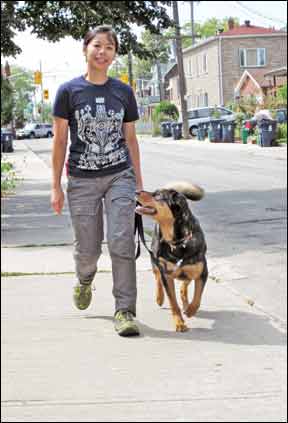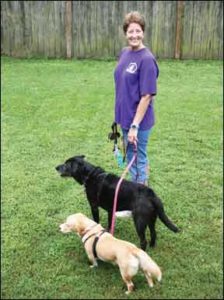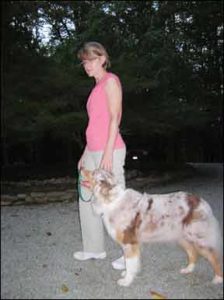
I’m sure I’m not the only dog trainer who sometimes shakes her head in frustration and dismay at her students’ apparent lack of success with teaching their dogs to walk politely on leash. Oh, they can do it just perfectly in the training center as I coach them to click and treat at random intervals. But when I stand at the window and watch them walk to their cars after class, the majority of dogs are leaning on the ends of their leashes as they strain to sniff enticing odors on their way back to their cars.
“Where have we failed?” I may think to myself – and then stop to remind myself that perhaps we haven’t. At this moment our students aren’t asking their dogs to walk politely, therefore no one is failing anything. I’m reminded of a cartoon I saw a while ago, of a dog marching by his owner’s side in perfect heel position, looking perfectly miserable while a stream of fascinating stimuli pass by that the dog would obviously love to investigate and can’t. The thought balloon over the dog’s head says, “Whose walk is this, anyway?”
Different Kinds of Dog Walking
There are, in fact, a variety of ways to walk on leash. The perfect-heel-position pas-de-deux dance required for obedience competition, while head-spinningly beautiful when performed well, requires focused concentration at both ends of the leash, with a high rate of some kind of reinforcement – treats, praise, or eye contact from the owner. It’s good for dogs and their people to know how to do this when requested, but unreasonable to expect them to walk this way all the time. Humans don’t want do that on a casual walk around the block, nor do their dogs. My own dogs, like those of my students, are quite capable of doing this when they know the perfect-heel game is on, but they’re not about to walk glued to my side when we’re strolling – or hiking – around the farm. In addition to the “Heel!” walk that we do in the training center (gaze with concentration into my eyes in perfect heel position, a.k.a. my walk), my dogs know two other ways to walk on when we’re on their walks. “Let’s walk!” is the cue I use to mean “You need to stay close to me but you can wander, sniff, and pee,” while “Be a dog!” means “You can range to the end of the leash in any direction, just don’t drag me.”
Each type of walking is taught according to the same basic formula: the dog is reinforced for being where I’ve asked her to be. The less freedom the dog has – the closer I want her to be by my side – the higher the rate and value of the reinforcer I use to train the behavior. When I want her to be in heel position, all the reinforcement comes from me, in the form of high-value treats and silly chatter. When the dog is fluent at walking by my side, I begin decreasing the rate of reinforcement, so she can walk politely for longer and longer stretches between reinforcers. When I offer more freedom on our walks, I can make use of the environment to reinforce my dog by doing “penalty yards” when the leash tightens. “Want to sniff that tree? Oops, the leash is tight, the tree goes farther away!” (We back up). “Now there is slack in the leash – look, the tree is getting closer!” (We move forward).
Make Walks Fun for Your Dog
Still, unless you’re a training junkie, practicing polite leash walking can be, well, let’s face it, pretty boring. If, however, you can make it a game, it suddenly becomes more fun for you and your dog. Play enough games, and your days spent on the other end of a tight leash may be over. Positive reinforcement training encourages creativity and fun. My own favorite approach is simply to be variable and unpredictable. If my dog never knows when I might toss a high-value treat on the ground, pull out a favorite toy, or head off on a tangent, she has to keep half an eye on me at all times. My goal is to happily surprise my dog; often enough that she decides it’s well worth her while to stay close to me.
There is no limit to the training tactics that can be used to teach leash walking in an enjoyable manner. Just leave it to a bunch of positive reinforcement trainers to come up with games designed to make leash walking fun. Here are a few examples:
Barbara Tran, CPDT-KSA, PMCT, in Toronto, Canada, takes “variable and unpredictable” to a new level with her leash-walking game, “Catch Me If You Can!” With this method, you “capture” the desired behavior (dog staying close to you) and the leash goes on only after the dog has been reinforced for staying near your side so much that she chooses to stay there. Tran describes how she played this game off-leash with her dog, Tashi. “Heeling doesn’t need to be dreadfully boring. I tried to dodge Tashi; if she got within a few feet of me, I marked her success with a clicker and fed her a treat. There was no force. It was completely her choice. Tashi chose to try and catch me because it was fun. “At first, we did this always at a fast pace and with lots of changes in direction, so it was truly a job for her to keep an eye on me. I released the treats beside my left leg, so she was always receiving her food rewards in proper heel position. Gradually, I began to introduce brief (initially, just a step or two) snippets of heeling at a normal pace. I clicked and rewarded her for paying attention to me while walking and then, we resumed our fast-paced game. Very gradually, and in an unpredictable pattern, I extended the periods of normal walking, so that sometimes there was little to no running. “Sometimes, I used running rather than food as a reward for attentive heeling. Sometimes, I threw a toy and released Tashi to go get it. Fun, fun, fun! Walking side by side became a predictor that we might play the ‘Catch me if you can’ game, or I might throw a toy, or I might supply a tasty treat.”
Lisa Waggoner, PMCT2, CPDT-KA, of Cold Nose College, in Murphy, North Carolina, says, “I like to get the dog accustomed to the ‘leash clasp hanging down’ (which means the leash has to be loose). I click/treat while the dog is standing still, clasp down/leash loose. The dog has to think, ‘It can be this easy?’ After a few rounds of this, we do what we call ‘the Box Step.’ We have fun with our clients talking about all those dancing lessons (we have mostly 60-80 year old clients).

“The Box Step involves taking a tiny step to the right. The dog may or may not move with us, but as long as the clasp is hanging down and the leash is loose, we click/treat. Then take a tiny step to the left; click/treat. Then a tiny step back; click/treat. Step forward; click/treat.
“Before long, the dog decides that staying very near is quite fabulous. Once the dog follows me in the small steps right/left/back/forward, then I transition, with the dog at my left, to taking two or three steps forward, clicking as the dog moves with me, taking treats at my left knee.”
Dawn Kalinowski of Poised Pups, LLC, in Norfolk, Virginia, takes the “penalty yards” technique mentioned previously and goes one step further, turning it into an training exercise. This exercise teaches the dog that a loose leash allows him to get closer to the prize but a tight leash causes him to lose ground. She suggests, “Start in a quiet room in your house. For this exercise, have a handful of tasty treats, or a toy if your dog is motivated by toys. Using a six-foot leash, tether your dog to something in a place where he can watch what you’re doing. Show him the yummy treat or toy. Walk about 8 to 10 feet away and place the treats or toy on the floor. “Walk back to your dog and pick up his leash.

Holding your leash hand close to your body, walk very slowly toward the ‘goodies.’ When your dog pulls toward the goodies (thus tightening the leash), give a ‘no reward marker’ (NRM) such as ‘Oops!’ and take him back to the starting place. When he is calm, again start your slow walk toward the goodies. When he pulls again say “Oops!” and once again go back to the starting position. “Continue this exercise until your dog can reach the goodies without any tightening of the leash. Ask him to wait, pick up the treats or toy and give him the goodies. Once your dog catches on, bring in exciting new goodies for him and change locations to different rooms in the house.”
Susan Kaminsky, CPDT-KA, PMCT, of The Country Dog, LLC, in Norwalk, Connecticut, utilizes “luring” to help the dog find opportunities for reinforcement in the desired walking position. She explains, “I work first with ‘follow me’ – in the house, a fenced-in yard, or on a long line – and I point a finger down in front of the dog’s nose, initially with a strong-smelling treat in that hand. Eventually I just use my finger. It is a fun game and the dog learns to pay attention to me without the restraint of a leash. I start walking at a fast trot, which also helps gain the dog’s attention, and I change direction frequently. This idea developed from a Patricia McConnell technique, but I added the pointing finger as I like having a visual cue.”
Tricia Lude, of Manassass, Virginia, is a dedicated dog hobbyist who competes in agility. Having her dogs work at her side while running is vital to her competitive success – and she takes her competition seriously. Lude says, “I do a lot of foundation work/games to get my dogs to love being at my side because in agility (which is my main focus), I need them driving along my side and not turning into me. I never actually train them to heel. After doing all these games, all they want to do is be at my side. Whenever I give them a treat or reinforcement, I turn so that they are at my side. When I cue them to sit, I have them at my side instead of in front of me. Since they get so much reinforcement at my side they tend to stick there. I also do the same thing when playing fetch or other such games. I have them sit at my side and wait before I throw the ball, and then I release them. Sometimes I just drop the ball, as if I was tossing a treat into their mouth, while they are at my side.

“I also do ‘perch work’ with them to get them to want to love to be at my side. I shape them to put their paws on a phone book wrapped up in duct tape or some other type of small perch type object. I click and reward them a lot for having their front paws on the perch, standing next to me. Next, I have them sit-stay a few feet to a few yards behind me and then release them to run to the perch by my side. I’ll start to add distractions by putting a food bowl about 10 feet in front of me. They have to run to the perch at my side, then I release them to get the treat or get a lick of peanut butter in the bowl. “I also shape them to spin in a circle around the perch. I add myself into the picture when they have learned to rotate around the perch. They then rotate into me. My dogs get so much reinforcement for being at my side that they that they want to be at my side no matter where I am. I can walk into the ring at an agility trial and they are glued to my side. I can walk backward, forward, or spin in circles, and they stay right there even without a leash. I fade the perch fairly quickly by using flatter books and then a piece of paper. In no time, they are running to my side and walking with me off leash with no problem.”
More Dog Walking Ideas
So there you have it. Boring leash-walking is out; fun leash walking is in. One of the marvelous things about positive reinforcement training is that there is no “one right way” to do things. There are as many ways as there are creative trainers to think them up. We’re betting there are a lot more leash-walking games out there that we haven’t heard of. We’re challenging you, again – this time to come up with more fun ideas for keeping your dog walking happily with you on a loose leash. Submit your ideas to WDJEditor@gmail.com and we’ll post our favorites on our WDJ Facebook page. In the meantime, keep on having fun walking with your dog! The exercise and fresh air is good for both of you.





Exploring all online gambling game on the internet has become one of the endeavors most enjoyed by users of gambling facilities nowadays.
How not, all the games that used to be abandoned enjoyed abroad by people
from the upper classes, now you can enjoy without having to leave the home and
use a more affordable cost to be active slot gambling in the
house.
This is all thanks to internet technology that can attach online gambling fans as soon as the best gambling encouragement providers approaching
the world. As in Indonesia itself, the attributed online gambling agent
site subsequently Depoxito is here to support those of you who desire
to spend forgive period taking into consideration atmosphere online gambling products.
Since its presence in the domestic online gambling industry,
Depoxito has presented various types of gambling games of the highest quality.
Games such as soccer betting, casino, shooting fish, poker, lottery,
and of course online slot games are handy with international standards because they arrive from leading gambling sites such
as Sbobet, Spade Gaming, Microgaming, Playtech,
and hence on.
For those of you who want to try out how thrill-seeking it is
to sham online gambling upon the approved gambling agent website Depoxito, sharply register now and enjoy the best online gambling
experience that you can’t locate anywhere else.